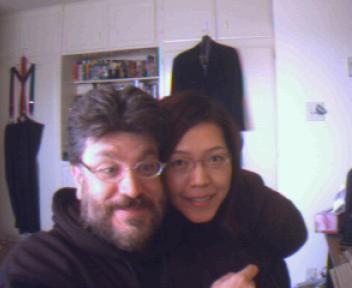By JOHN SCHWARTZ
The liftoff, top, and pictures from the shuttle Discovery
as it broke away from its external tank
CAPE CANAVERAL, Fla., July 26 - Now that the Discovery is in orbit, the examination begins. Its 12½-day mission will be the most photographed in the history of the shuttle program, with all eyes on the craft to see if it suffered the kind of damage from blastoff debris that brought down the Columbia in February 2003.
There were cameras on the launching pad, cameras aloft on planes monitoring the ascent, cameras on the shuttle checking for missing foam on the external fuel tank, and a camera on the tank itself. One camera caught a mysterious object falling from the shuttle at liftoff; radar detected another, about two minutes into the flight. Cameras aboard the shuttle and the International Space Station will monitor the Discovery until the end of its mission.
But all this inspection may be a mixed blessing. The more NASA looks for damage, engineers and other experts say, the more it will find. And the risks of overreaction to signs of damage while the shuttle is in orbit may be just as great as the risks of playing them down.
"How do you distinguish - discriminate - between damage which is critical and damage which is inconsequential?" asked Dr. David Wolf, an astronaut who spent four months aboard the Russian space station Mir. "We could be faced with very difficult decisions, in part because of all this additional information that we will be presented with."
The shuttle program has lived with damage from debris from the very first flight, in 1981; in 113 missions the orbiters have been hit by debris some 15,000 times, mostly on liftoff. The National Aeronautics and Space Administration replaces about 100 insulating tiles after every flight and repairs many more than that, Stephanie S. Stilson, the vehicle manager for Discovery, said Monday.
Now, though, it will be far easier to spot such damage while the shuttle is still in orbit. Thanks to a $15 million laser camera system developed by a Canadian company, Neptec, for example, NASA can detect a crack of just two-hundredths of an inch, the width of two business cards pressed together. On the leading edge of the orbiter's wing, such a crack could admit dangerous amounts of superheated gas during re-entry. A similar crack elsewhere might not.
It was a large hole in the left wing's leading edge, caused by impact with a 1.67-pound piece of insulating foam during the launching, that led to the Columbia disaster.
But if a crack is detected, said Iain Christie, director of research and development for Neptec, "how is NASA supposed to explain that this is not a problem?"
Nor is it clear how it could be fixed. NASA's efforts to create a repair kit for tile and leading-edge panels, a recommendation of the board that investigated the Columbia accident, have not been successful. Techniques will be tested during a spacewalk in coming days, but they are not ready for an actual repair, and the Discovery astronauts have said they would not want to trust any patchwork on a return to Earth.
Another option, the "safe haven" plan, would involve abandoning the $2 billion shuttle and having the astronauts wait in the space station for a rescue mission. For that to work, another shuttle would have to be launched within a few weeks.
That is theoretically possible but carries risks of its own: the chance, for example, that the orbiting astronauts would run out of food, water or oxygen before the mission could be mounted.
"There is risk in anything you do," Kyle Herring, a NASA spokesman, said. "Staying at the station is risky."
The intense scrutiny of the Discovery's mission is an effort to make up for decades of ignorance. Until the Columbia accident, NASA officials generally believed that something as light as insulating foam could not harm the shuttle. The disaster sent the space agency into a two-year struggle to learn just how fragile the craft's thermal protection system is and how to detect damage to it.
Much of the effort has been devoted to determining what kind of damage needs immediate action and what can be left until the shuttle is safely home. The search for a range of allowable debris hits has involved millions of computer simulations and testing with wind tunnels, arc jets and more, Mr. Herring said.
History, too, is a guide. "We have this database of 15,000 tile damages," Mr. Herring said, "and we know what those sizes are."
But Edward Tenner, an author and expert on technology issues, warned that using technology to analyze complex systems cut both ways. While such analysis can "give you a true power and a true view" of a problem, he said, it can "make it look better than it really is." He called this "the illusion of control."
Dr. Wolf, the astronaut, who has a medical degree, likened the problem to that facing doctors, with their increasingly powerful diagnostic tools.
Dr. H. Gilbert Welch, a professor of medicine at Dartmouth and an expert on medical diagnosis, agreed. "A lot of what we're calling disease now never becomes clinically apparent during the life of the patient," he said. "Everything you find is less threatening, but you can never say anything is a zero threat."
NASA faces a similar challenge, he said: "I'm sure they want to do the best they can. But the harder they look, they'll find more things."

No comments:
Post a Comment